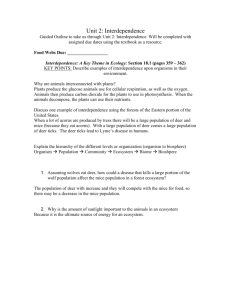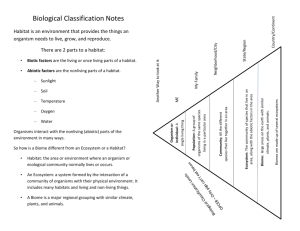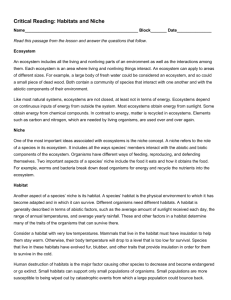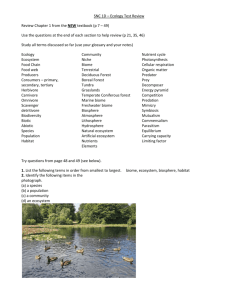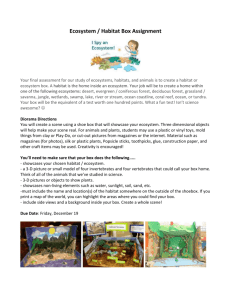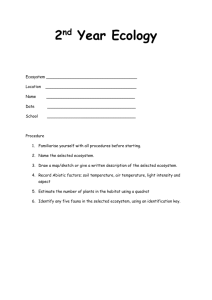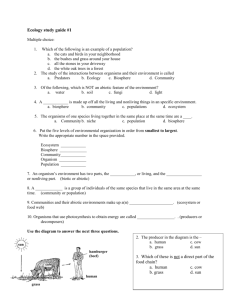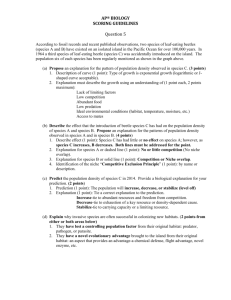Components of Ecosystems
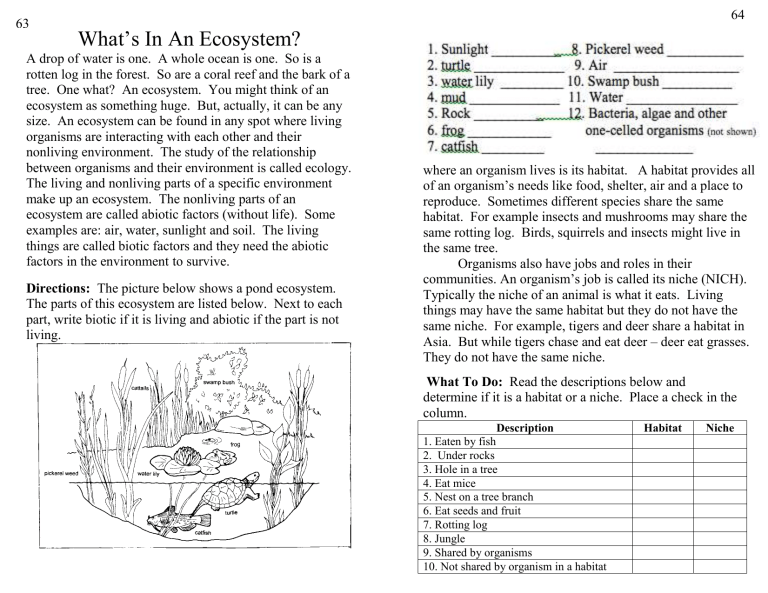
63
What’s In An Ecosystem?
A drop of water is one. A whole ocean is one. So is a rotten log in the forest. So are a coral reef and the bark of a tree. One what? An ecosystem. You might think of an ecosystem as something huge. But, actually, it can be any size. An ecosystem can be found in any spot where living organisms are interacting with each other and their nonliving environment. The study of the relationship between organisms and their environment is called ecology.
The living and nonliving parts of a specific environment make up an ecosystem. The nonliving parts of an ecosystem are called abiotic factors (without life). Some examples are: air, water, sunlight and soil. The living things are called biotic factors and they need the abiotic factors in the environment to survive.
Directions: The picture below shows a pond ecosystem.
The parts of this ecosystem are listed below. Next to each part, write biotic if it is living and abiotic if the part is not living.
The
64 place where an organism lives is its habitat. A habitat provides all of an organism’s needs like food, shelter, air and a place to reproduce. Sometimes different species share the same habitat. For example insects and mushrooms may share the same rotting log. Birds, squirrels and insects might live in the same tree.
Organisms also have jobs and roles in their communities. An organism’s job is called its niche (NICH).
Typically the niche of an animal is what it eats. Living things may have the same habitat but they do not have the same niche. For example, tigers and deer share a habitat in
Asia. But while tigers chase and eat deer – deer eat grasses.
They do not have the same niche.
What To Do: Read the descriptions below and determine if it is a habitat or a niche. Place a check in the column.
1. Eaten by fish
Description Habitat Niche
2. Under rocks
3. Hole in a tree
4. Eat mice
5. Nest on a tree branch
6. Eat seeds and fruit
7. Rotting log
8. Jungle
9. Shared by organisms
10. Not shared by organism in a habitat
65
The oak tree above is like a neighborhood for many animals. On or in the oak tree is the specific habitat and niche for each animal. Read the information below and determine the habitat and niche for each animal.
Place the information in the chart on the next page.
1. The robin nests in the lower branches and feeds on insects and worms found on the ground. Circle in blue.
2. The gray squirrel nests in the upper branches of the tree and feeds on the acorns. Circle in yellow.
3. The downy woodpecker feeds on the insects and grubs that live in the bark of the tree. It may also nest inside a dead branch of the tree. Circle in green.
4. The caterpillar feeds on the leaves of the tree and spins its cocoon there. Circle in brown.
5. The Baltimore oriole nests high in the branches of the tree and feeds on the insects that live on the tree.
Circle in red.
6. The whitetail deer finds shelter under the tree and feeds on the acorns that drop to the ground. Circle in purple.
66
Organism
Robin
Grey Squirrel
Downy
Woodpecker
Caterpillar
Baltimore Oriole
Habitat Niche
Whitetail deer
The picture below shows a student observing and recording a square of his schoolyard. This small square is called a microhabitat.
In the chart below list the biotic and abiotic factors in the microhabitat.
Biotic Factors Abiotic Factors
67
Name _________________ period _____
EXIT TICKET
What’s an Ecosystem?
1. Which list below contains only biotic factors?
A. Rocks, air, water, sunlight
B. Air, sunlight, rabbits, grass
C. Rabbits, grass, hawks, mice
2. Which list below contains only abiotic factors?
A. Rocks, air, water, sunlight
B. Air, sunlight, rabbits, grass
C. Sunlight, rabbits, grass, hawks
3. Which describes the habitat of an organism?
A. Rotting log
B. Chases deer
C. Eats grass
4. Which describes the niche of an organism?
A. Rotting log
B. Chases deer
C. Eats grass
5. Which of the places below would be considered a microhabitat?
A. East Texas Piney Woods
B. A small part of the soccer field
C. Mojave Desert
Name _________________
67 period _____
EXIT TICKET
What’s an Ecosystem?
1. Which of the places below would be considered a microhabitat?
A. East Texas Piney Woods
B. A small part of the soccer field
C. Mojave Desert
2. Which list below contains only biotic factors?
A. Rocks, air, water, sunlight
B. Air, sunlight, rabbits, grass
C. Rabbits, grass, hawks, mice
3. Which list below contains only abiotic factors?
A. Rocks, air, water, sunlight
B. Air, sunlight, rabbits, grass
C. Sunlight, rabbits, grass, hawks
4. Which describes the habitat of an organism?
A. Rotting log
B. Chases deer
C. Eats grass
5. Which describes the niche of an organism?
A. Rotting log
B. Chases deer
C. Eats grass
